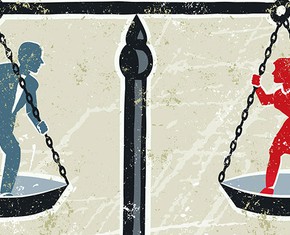The views expressed in our content reflect individual perspectives and do not represent the authoritative views of the Baha'i Faith.
The African American pastor, Rev. Richard Manuel Bolden, who led Harlem’s First Emmanuel Church early in the 20th century, proclaimed the return of Christ and linked it to racial unity.
On Sunday, March 24, 1918, Reverend Bolden preached, as reported in an article from an unnamed reporter for the The New York Age, that Christ would return soon — and that one sure way to tell would be when the distinctions of race would vanish without a trace:
The beautiful weather of last Sunday brought out a large crowd at the first Emmanuel Church. At the 11 o’clock service Pastor Bolden delivered an eloquent sermon from St. Matthew XXV, 13: “Watch therefore, for ye know neither the day nor the hour when the Son of Man cometh.” The theme, “Watch, Investigate, Look.” Pastor Bolden said that there will soon be a consummation of all things, and that there will be “neither black nor white nor yellow races, but Sons of God: the resurrection of a new man.”
RELATED: Harlem’s First Emmanuel Church and the Baha’i Principle of Racial Unity
Now let’s fast-forward nearly two years later, when that same prophecy was on the verge of being fulfilled. Here’s what happened:
On Saturday, January 24, 1920, The New York Age reported that weekly Baha’i meetings would start to take place on Sunday afternoons: “The Bahai movement will conduct meetings every Sunday afternoon at the church from 3.15 to 4.15 p. m.”
This announcement was limited, albeit public, accompanied by no fanfare, no promotion, and no hype. It did not even include a definition of what the “Bahai movement” was all about. From this small beginning, however, weekly Baha’i meetings continued to gather momentum, attract interest, and engage speakers who presented talks on a wide array of topics. The meetings were more frequently reported as time went on, even adding a second regular meeting, previously referred to as the “Rainbow Circle,” featuring readings from the Baha’i sacred texts, and talks by Baha’is or from among the regular attendees. Consider, for instance, Sunday, July 24, 1921, on which the following New York Age newspaper story was published:
First Emmanuel Church.
The services on last Sunday at the First Emmanuel Church, especially at the 11 o’clock service were largely attended. Pastor Bolden preached from Luke 16:10. Pastor Bolden asked the question if in the great world questions have men been faithful in the little things? In the economical things? In religious things? In the love of mankind? God’s world begins with the little things, the atoms. The big things take care of themselves. …
The members of the Bahai Association were very glad to see their president Miss M. Van Blacum at the meeting at 3:30 p. m. A very pleasant time was had. Among the speakers were Mrs. Forel, Mr. Morris and others. Pastor Bolden made the closing remarks. On last Friday night [July 29, 1921] the members of the Association and friends motored in West Englewood, N. J. where an outdoor service was held at Mr. R. Wilhelms camp. …
A meeting that partook of much spiritual fervor was held on last Thursday night by members of the Rainbow Circle and was largely attended. Pastor Bolden conducted the opening exercises, and Mr. Fieldman read an address from Abdul Bahar [Abdu’l-Baha’s] book, entitled “The difference which exists between man and the animal.” Addresses were made by Rev. Bolden, Mrs. Silverberg; Mrs. F. Kruge and Mr. Morris. Closing remarks and prayer by Mrs. Ford.
Here, Abdu’l-Baha’s book apparently refers to Some Answered Questions, first published in 1908 and specifically named in other newspaper entries. (See the new translation of Some Answered Questions here.) In the previous edition, Chapter 48 is entitled, “The Difference Existing between Man and Animal.” This excerpt, most probably read in the First Emmanuel Church over 101 years ago, describes the Baha’i view on the inner human spirit:
This it is impossible for the animal to perceive. In the same way, it cannot understand that the sun is the center and that the earth revolves around it. The animal is the captive of the senses and bound by them; all that is beyond the senses, the things that they do not control, the animal can never understand, although in the outer senses it is greater than man. Hence it is proved and verified that in man there is a power of discovery by which he is distinguished from the animals, and this is the spirit of man.
Praise be to God! man is always turned toward the heights, and his aspiration is lofty; he always desires to reach a greater world than the world in which he is, and to mount to a higher sphere than that in which he is. The love of exaltation is one of the characteristics of man. I am astonished that certain philosophers of America and Europe are content to gradually approach the animal world and so to go backward; for the tendency of existence must be toward exaltation. Nevertheless, if you said to one of them, “You are an animal,” he would be extremely hurt and angry.
Over time, exposure to and enrichment by the Baha’i teachings ultimately led to the apparent conversion of the congregation of First Emmanuel Church and its pastor, Rev. Bolden, to the “Bahai movement.” Another Black newspaper, The Washington Bee, reported in 1920:
One of the most notable successes of the cause is in Harlem, where an entire church has become Bahai. At a recent meeting the pastor, Rev. Mr. Bolden, declared himself a Bahai. He said he had studied the Bahai cause and it had not made him less loyal to Christ; but he had discovered that this was a new Sun arisen in the horizon of truth.
The very next week, The New York Age reported the Rev. Bolden had received a “Tablet” (a special letter) that was read aloud to the entire congregation in church: “M. A. Zorab [Sohrab] made a splendid talk and read a letter which was sent to pastor Bolden from Abdul, Bahai [Abdu’l-Baha.”]
This conversion to the Baha’i Faith of Rev. Bolden and the First Emmanuel Church congregation no doubt soon created opposition from some within this otherwise Christian setting. Bolden’s Church was already outside the Black community mainstream physically, because it was founded at the edge of segregated spaces in the city as they were established at the time. The geographic placement of Rev. Bolden’s church was seemingly situated so White audiences could also attend if they wished, although this drew negative attention at the time from White media.
We can infer this opposition from the church’s loud silence in the fall of 1922, when all mention of the “Bahai Association” and the “Rainbow Circle” and Abdu’l-Baha and his “book” abruptly ceased without comment from the regular “News of the Churches” columns published by The New York Age newspaper for many years.
Several subsequent articles reveal, however, that Rev. Bolden himself returned to the interracial activities held at Baha’i Roy Wilhelm’s “camp” in June of 1926 and again in April, 1927, when “Mr. Morton was followed by the Rev. Richard Bolden, pastor of the Harlem Immanuel Church, who spoke with the fire and feeling of his gifted race, on the significance of Abdu’l-Baha as a racial unifier.” Meanwhile, the prominent African American attorney and Baha’i, Louis Gregory, spoke again to the First Emmanuel Church in 1926.
RELATED: Harlem, 1920: An Entire Black Church Embraces the Baha’i Faith
The Baha’i scholar Richard Hollinger has positively identified “M. Van Blacum,” cited in the The New York Age coverage as “of Montclair, NJ,” who regularly led the Baha’i Association meetings and often the Rainbow Circle meetings, as well as speaking at other occasions of the Church over more than two years of weekly meetings as “Anna Van Blarcom,” a Baha’i woman who lived in Montclair, New Jersey. She received the following Tablet from Abdu’l-Baha:
To the maid-servant of God, Anna Van Blarcom, Montclair, New Jersey …
O thou who art encompassed with the blessings of God!
Thy letter was received. Praise be to God, it contained good news, namely that a group of colored men have become illumined and have acquired a new zeal and ardor. When I was in America, I exerted a great deal of effort in order to promote a great harmony and union among the white and the colored, for men are like unto doves which associate in perfect concord and amity whether white, black, yellow or red in color. My hope is that this may happen among men. Consider ye, that color has been obliterated among birds, among whom distinction in color does not prevent intimate association. The same applies to animals which give no importance to color, but rather take into consideration the species.
How then can man, who is the highest type in the world of creation, attach importance to unimportant matters and make difference in color the cause of alienation and enmity?
Endeavor ye, therefore, to bring about absolute affiliation between the white and the colored. This variety in color is indeed an ornament. If in a rose-garden all the flowers are unicolored, what beauty may be found therein?
Whereas if thou beholdest a garden wherein multicolored flowers bloom, infinite grace and beauty will appear therefrom.
Likewise if the world of mankind were of one color what preference would it have? Whereas multiplicity of color is an emblem of the Power of the Merciful.

















Comments
Sign in or create an account
Continue with Googleor